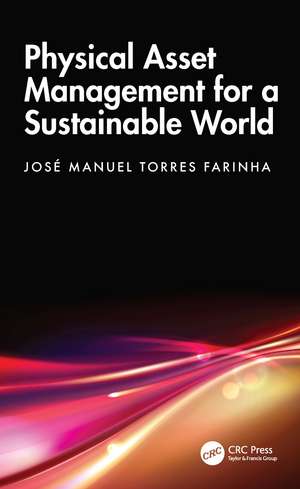Physical Asset Management for a Sustainable World
Autor José Manuel Torres Farinhaen Limba Engleză Hardback – oct 2024
Features:
- Covers important aspects on Physical Asset Management (PAM) and offers a developed perspective on the economic aspects.
- Presents the relationships among some maintenance Key Performance Indicators (KPI), specifically MTTR, MTBF, Availability, and Reserve equipment.
- Analyzes models to calculate the influence of relevant variables on the withdrawal time and in the reserve size of the critical assets.
- Introduces new diagnostic models and Life Cycle decision support models.
- Includes new models for diagnosing organizations including pertinent case studies.
Preț: 795.25 lei
Preț vechi: 969.81 lei
-18% Nou
Puncte Express: 1193
Preț estimativ în valută:
152.19€ • 165.26$ • 127.84£
152.19€ • 165.26$ • 127.84£
Carte tipărită la comandă
Livrare economică 22 aprilie-06 mai
Preluare comenzi: 021 569.72.76
Specificații
ISBN-13: 9781032428352
ISBN-10: 103242835X
Pagini: 462
Ilustrații: 466
Dimensiuni: 156 x 234 mm
Greutate: 0.82 kg
Ediția:1
Editura: CRC Press
Colecția CRC Press
Locul publicării:Boca Raton, United States
ISBN-10: 103242835X
Pagini: 462
Ilustrații: 466
Dimensiuni: 156 x 234 mm
Greutate: 0.82 kg
Ediția:1
Editura: CRC Press
Colecția CRC Press
Locul publicării:Boca Raton, United States
Public țintă
Academic and PostgraduateNotă biografică
José Manuel Torres Farinha has Habilitation in Electrical and Computer Engineering, a PhD in
Mechanical Engineering and a degree in Electrical Engineering, option Energy. He is a National
Defence Auditor. He is Full Professor in Coimbra Polytechnic Institute (IPC) and its former
President. He is the Coordinator of the Master's Degree in Engineering and Management of
Physical Assets in IPC. He has completed several PhD supervisions and dozens of Master's
degree orientations. He has published three books, two in National edition and one in
International edition. He has more than 250 publications – articles in indexed and non-indexed
international journals, in national magazines and in proceedings of international and national
congresses. He has several registered patents (National and International). He is Specialist
Member of Industrial Maintenance Specialization and a Counsellor Member of the Portuguese
Association of Engineers.
Mechanical Engineering and a degree in Electrical Engineering, option Energy. He is a National
Defence Auditor. He is Full Professor in Coimbra Polytechnic Institute (IPC) and its former
President. He is the Coordinator of the Master's Degree in Engineering and Management of
Physical Assets in IPC. He has completed several PhD supervisions and dozens of Master's
degree orientations. He has published three books, two in National edition and one in
International edition. He has more than 250 publications – articles in indexed and non-indexed
international journals, in national magazines and in proceedings of international and national
congresses. He has several registered patents (National and International). He is Specialist
Member of Industrial Maintenance Specialization and a Counsellor Member of the Portuguese
Association of Engineers.
Cuprins
PART I Life Cycle Models. 1 Life Cycle Cost of Physical Assets. 1.1 Introduction. 1.2 Life Cycle Models. 1.3 Economic Life Cycle. 1.4 Performance Indicators. 1.5 Investment Analysis Methods. 1.6 New Economic Replacement Models. 1.7 Reserve Set. 1.8 Life Cycle Considering Incomes. 1.9 Simulation of Methods Application. References. 2 Life Cycle Investment of Physical Assets. 2.1 Introduction. 2.2 The Model of a Holistic Approach of the Physical Assets Life Cycle. 2.3 LCI Considering Maintenance and Non‑Production. 2.4 Case Study Simulation. 2.5 Conclusions. References. 3 Life Cycle of Physical Assets with Recovery. 3.1 Introduction. 3.2 Methodology. 3.3 Basic Concepts to Support Math Models. 3.4 Behaviour of the Physical Asset Value along Time. 3.5 Production Economic Movements. 3.6 Functioning Economic Movements. 3.7 Global Movements Analysis. 3.8 Return on Investment. 3.9 Models Validation and Discussion. 3.10 Conclusions. PART II Maintenance Methodologies. 4 Maintenance Types and Strategies. 4.1 Introduction. 4.2 Predetermined Maintenance. 4.3 Corrective Maintenance. 4.4 Enterprise Asset Management Systems. 4.5 Maintenance Performance. References. 5 Maintenance Algorithms. 5.1 Introduction. 5.2 Stochastic Algorithms. 5.3 Artificial Intelligence Algorithms. References. PART III Standards. 6 Maintenance Standards. 6.1 Introduction. 6.2 Characterization of Maintenance Standard NP 4492. 6.3 Diagnosis of the Maintenance State. 6.4 Diagnosis to Implement the Standard NP 4492. 6.5 Economic Implications of Implementing Maintenance Standards. Reference. 7 Norms of Physical Assets Management. 7.1 Introduction. 7.2 Main Requisites of Physical Asset Norms. 7.3 Diagnosis to Implement Physical Asset Norms. 7.4 Quantitative Evaluation to Implement Physical Asset Norms. 8 Risk Norms. 8.1 Introduction. 8.2 Characterization of Risk Norms. 8.3 Diagnosis to Implement Risk Norms. 8.4 Quantitative Evaluation about the Implementation of Risk Norms. Reference. 9 Energy Norms. 9.1 Introduction. 9.2 Characterization of Energy Norms. 9.3 Diagnosis to Implement Energy Norms. 9.4 Quantitative Evaluation about the Implementation of Energy Norms. 10 Environmental Norms. 10.1 Introduction. 10.2 Characterization of Environmental Norms. 10.3 Diagnosis to Implement Environmental Norms. 10.4 Quantitative Evaluation about the Implementation of Environmental Norms. Reference.
Descriere
The book describes techniques, tools and models about Engineering Maintenance and and Life Cycle Models, aimed at the efficiently managing of assets. It presents new asset management models including quantitative decision support tools for life management of physical assets supported by pertinent case studies.
